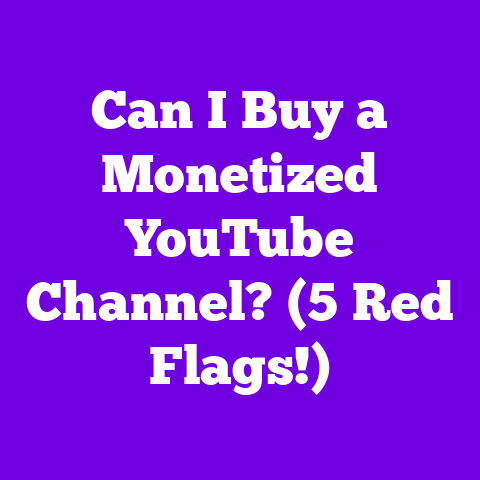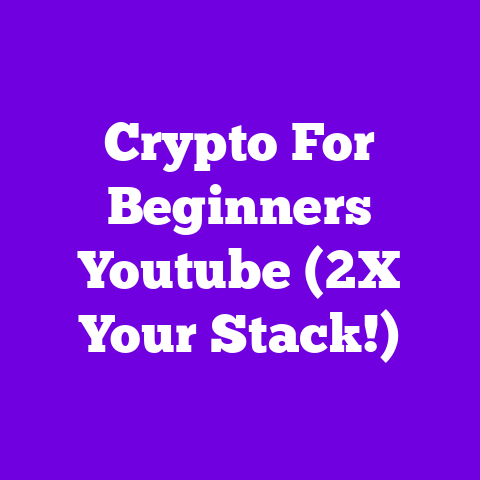Brand Account Youtube Meaning (3-Minute Fix!)
Ever wonder how your personal life intertwines with your YouTube brand?
As content creators, we’re constantly juggling the personal and professional.
It’s a tightrope walk, isn’t it?
Think about it: your lifestyle, your passions, your quirks – they all contribute to the unique flavor of your content.
But how do you translate that authenticity into a professional brand that resonates with your audience and attracts those sweet sponsorships?
That’s where Brand Accounts come in.
They’re not just a feature; they’re a necessity for anyone serious about building a thriving YouTube presence.
I’ve seen firsthand how a well-managed Brand Account can catapult a channel from obscurity to success.
In this article, I’ll break down everything you need to know about Brand Accounts on YouTube, especially with 2025 on the horizon.
We’ll dive into what they are, why they matter, and how to set one up for maximum impact.
Buckle up – it’s time to level up your YouTube game!
Section 1: What is a Brand Account on YouTube?
Okay, let’s get down to brass tacks.
What exactly is a Brand Account on YouTube?
Simply put, it’s a YouTube channel that isn’t directly tied to your personal Google account.
Think of it like this: your personal account is you – your name, your email, your everything.
A Brand Account, on the other hand, is a separate entity, like a mini-corporation for your YouTube channel.
Here’s what sets Brand Accounts apart:
- Multiple Managers: You can grant access to multiple people to manage the channel without sharing your personal Google account password.
This is HUGE for collaboration. - Separate Branding: You can customize the channel name, logo, and overall branding independently from your personal Google profile.
- Enhanced Analytics: Brand Accounts provide more in-depth analytics and insights into your audience and content performance.
Why is this important?
Imagine you’re a growing channel.
Let’s say you’re a gaming channel, and you want to bring on a friend to help manage your comments and upload videos.
With a personal account, you’d have to share your Google password.
Yikes!
With a Brand Account, you can grant them access without compromising your personal security.
For businesses and content creators, Brand Accounts are crucial for establishing a professional image.
It’s about separating your personal identity from your brand, creating a dedicated space for your content, and having the flexibility to collaborate with others.
According to Google, Brand Accounts are specifically designed for businesses and brands, and they offer features that personal accounts simply don’t.
Section 2: The Evolution of Brand Accounts
Brand Accounts haven’t always been what they are today.
They’ve evolved significantly over time, adapting to the changing landscape of YouTube and content creation.
Back in the early days, YouTube was a wild west.
Most creators used personal accounts for everything.
As the platform matured, the need for a more structured and professional approach became apparent.
Here’s a quick timeline:
- Early 2010s: Brand Accounts started as a way for businesses to have a presence on YouTube without directly linking to a personal Google account.
- Mid-2010s: YouTube introduced features like multiple managers and improved analytics, making Brand Accounts more attractive to content creators.
- Late 2010s: As influencer marketing exploded, Brand Accounts became essential for collaborations and sponsorships.
- Present Day: Brand Accounts are now a standard feature on YouTube, offering a wide range of tools and functionalities for creators of all sizes.
One of the key changes that affected Brand Accounts was YouTube’s evolving monetization policies.
In the past, it was easier to monetize a channel, regardless of whether it was a personal or Brand Account.
However, as YouTube tightened its policies to combat spam and low-quality content, Brand Accounts became the preferred option for monetization, as they offered more transparency and control.
I remember when I first started using a Brand Account.
The ability to delegate tasks to my team without sharing my personal login was a game-changer.
It freed up my time to focus on creating content and engaging with my audience.
The rise of influencer marketing further solidified the importance of Brand Accounts.
Brands want to work with creators who have a professional image and the ability to track their performance.
A Brand Account provides that level of professionalism and data-driven insights.
Section 3: Why Brand Accounts Matter in 2025
Okay, let’s fast forward to 2025.
What will the content creation landscape look like, and why will Brand Accounts be even more critical?
I predict that the competition for eyeballs will be fiercer than ever.
With the rise of short-form video platforms like TikTok and the continued dominance of YouTube, creators will need every advantage they can get.
Here’s why Brand Accounts will be essential in 2025:
- Enhanced Visibility and Reach: In a crowded digital space, a well-optimized Brand Account can help you stand out from the noise.
- Seamless Collaborations: Brands will be looking for creators with professional Brand Accounts that offer transparency and data.
- Targeted Audience Engagement: Brand Accounts provide the tools to understand your audience and tailor your content accordingly.
Imagine you’re launching a new product and want to collaborate with a YouTuber.
Would you rather work with someone who has a personal account with limited analytics or someone with a Brand Account that provides detailed insights into their audience demographics and engagement metrics?
The answer is obvious.
I believe that audience engagement will become even more personalized and interactive.
Brand Accounts will be essential for managing these interactions, responding to comments, and building a loyal community.
Furthermore, the rise of AI and machine learning will likely play a significant role in content creation.
Brand Accounts will need to adapt to these changes, leveraging AI-powered tools to optimize their content and reach a wider audience.
Section 4: Setting Up a Brand Account
Alright, let’s get practical.
How do you actually set up a Brand Account on YouTube?
Don’t worry, it’s not rocket science.
I’ll walk you through it step-by-step.
Here’s the breakdown:
- Sign in to YouTube: Use your personal Google account to sign in to YouTube.
- Go to your channel list: Click on your profile picture in the top right corner and select “Settings.” Then, click on “Add or manage your channel(s).”
- Create a new channel: Click on “Create a new channel.”
- Enter a Brand Account name: This is the name that will be displayed on your YouTube channel.
- Verify your account: Follow the instructions to verify your account using your phone number.
Technical Aspects:
- Linking to a Google Account: Your Brand Account will be linked to a Google Account, but it will have its own separate identity.
- Customizing Channel Art: Make sure to upload a professional-looking banner and profile picture that represent your brand.
- Setting Up Channel Sections: Organize your content into sections to make it easier for viewers to find what they’re looking for.
Tips for Optimization:
- Use relevant keywords in your channel name and description. This will help people find your channel when they search on YouTube.
- Create a compelling channel trailer that showcases your best content.
- Promote your channel on social media and other platforms.
I always recommend spending time crafting your channel art and description.
These are the first things people will see when they visit your channel, so make sure they make a good impression.
Don’t forget to set up channel sections.
This will help viewers navigate your content and find what they’re looking for.
For example, you can create sections for your popular videos, playlists, and recent uploads.
Section 5: Best Practices for Managing a Brand Account
Creating a Brand Account is just the first step.
The real work begins when you start managing it.
Here are some best practices to keep in mind:
- Content Calendar Planning: Create a content calendar to plan your videos in advance.
This will help you stay organized and consistent. - Video Production: Invest in good quality equipment and editing software.
Your videos should look and sound professional. - Audience Interaction: Respond to comments, ask questions, and engage with your audience.
This will help you build a loyal community.
Analytics and Metrics:
- Track your views, watch time, and subscriber growth.
- Analyze your audience demographics to understand who is watching your videos.
- Use YouTube Analytics to identify your best-performing content.
Community Building:
Don’t be afraid to experiment with different types of content.
Try new formats, collaborate with other creators, and see what resonates with your audience.
Remember, building a community takes time and effort.
Be patient, engage with your audience, and create content that they love.
Section 6: The Future of Brand Accounts
Now, let’s gaze into our crystal ball and predict the future of Brand Accounts on YouTube.
What changes can we expect to see in 2025 and beyond?
I believe that YouTube will continue to evolve, incorporating new technologies and features to enhance the user experience.
Brand Accounts will need to adapt to these changes to stay relevant.
Here are some potential developments:
- AI-Powered Tools: YouTube may introduce AI-powered tools to help creators optimize their content, generate video ideas, and automate tasks.
- VR/AR Integration: Virtual and augmented reality could become more prevalent on YouTube, offering new opportunities for immersive content.
- Personalized Experiences: YouTube may become even more personalized, tailoring content recommendations to individual viewers.
Adaptability and Innovation:
- Stay up-to-date with the latest trends and technologies.
- Experiment with new formats and content styles.
- Be willing to adapt your strategy as needed.
I think AI will play a significant role in the future of Brand Accounts.
Imagine being able to use AI to generate video scripts, create thumbnails, and even edit your videos automatically.
VR and AR could also revolutionize the way we consume content on YouTube.
Imagine being able to step inside a video and experience it in a whole new way.
The key to success in the future will be adaptability and innovation.
Creators who are willing to embrace new technologies and experiment with new formats will be the ones who thrive.
As we move closer to 2025, the importance of aligning your lifestyle with your brand strategy will only grow.
Your authenticity, your passions, and your unique perspective are what will set you apart from the crowd.
By leveraging the power of a Brand Account, you can create a professional image, build a loyal community, and achieve your goals as a content creator.
Don’t just sit on the sidelines.
Take action today and consider how a Brand Account could elevate your YouTube presence and help you achieve your dreams.
The future of content creation is here, and it’s waiting for you to seize it.





